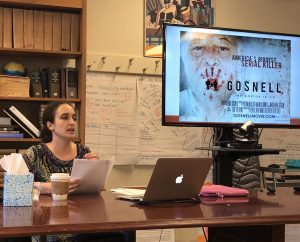
On Wednesday, February 28, the HHIVE Lab hosted Emily Winderman for its Grand Round Series. Professor Winderman is an assistant professor in the Communications Department as North Carolina State University and is currently in the process of writing “The Back Alley: The Rhetorical History.” She visited the lab to discuss her findings in her search for the consequences of the use of the term the “back alley” and its transformation from describing a cement passageway behind a building to its description of the highly controversial issue of abortion.
The phrase was first referenced in an 1884 court case regarding a boundary dispute and has since evolved, describing everything from undesirable places in New York City to the evasion of government in abortions. Despite the actual concept it is describing, Professor Winderman stated that back alleys generally create feelings of disgust and distaste. The feelings, she emphasized, lead to a transfer of emotion from the word to the aspect that it is metaphorically linked to.
Her discussion centered around the Kermit Gosnell Grand Jury Report in the 2013 case in which a doctor was found completing haphazard abortions in an unsanitary clinic in Philadelphia, Pennsylvania. The court case convicted the doctor of first degree murder and manslaughter. However, Winderman focused not on the main findings from the report but on the rhetoric used to describe them. The clinic was described as “filthy” and “the stench of urine filled the air.” It found that unlicensed teenagers had administered anesthesia and “smells of the very vehicles of contagion.”
Professor Winderman then explained how these characteristics appeal to the emotion of the audience. According to her, “the grand jury report was predicated on a pathos appeal to rhetorical disgust.” Through an analysis of the tactile and the ocular, the report introduced textured feelings that allowed anti-abortion movements to lead a sensual based opposition to the legalization of abortion. This led to the production of films including one on the case itself titled “America’s Biggest Serial Killer: The Doctor is Sin.” The film gained relative popularity very quickly and amassed 2.24 million dollars in donations between March and May of 2017.
Professor Winderman concluded her talk with a reading exemplifying the back alley used in a form of literature. The poetry allowed the audience to put into perspective the ease with which words and phrases can have a subconscious impact on opinions. Professor Winderman read from “Alleys Past and Present,” a poem about concrete written in 1917 before the term alley was used to describe abortions. The poem reads “disease germs multiple and people wondered why so many people died” which made it clear that it is almost impossible for the two concepts to remain completely separated.
To wrap up the presentation, Professor Winderman opened the floor to questions, which prompted intriguing discussion that was beneficial to both the speaker and the audience. Members discussed abortion as a class issue, differences between care in rural and urban areas and responsibilities of the legal observer and his or her interaction with the issue.
__________________________________________________
Kate Capitano is a first year undergraduate student majoring in Global Studies. Her concentration is Public Health and Environment with Latin America as the area of study. She is also on the pre-med track and hopes to combine the two through the Medicine, Literature, and Culture Minor. Specifically interested in women’s rights and health, Kate hopes of one day becoming an OBGYN.


